John Wayne Cook – Set Design
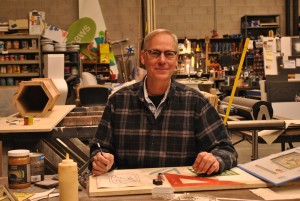
John Wayne Cook transports audiences from a theater seat to locations anywhere from Egypt to Japan or Shakespeare’s England. John, as the company’s scenic artist, designs, builds and paints Utah Opera’s backdrops and sets in a cavernous work space at the Utah Symphony/Utah Opera offices .
Cook’s love for the job has been evident in his 35 years of building beautiful sets. According to Renee Huang, Director of Public Relations for Utah Symphony and Utah Opera, “John is one of the foremost scenic artists around,”
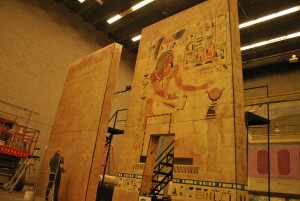
Currently working on a set for a production of Aida in Sarasota, Florida, Cook concentrates on each tiny detail of the project. He makes new sets for Utah Opera as needed, and other opera companies both commission his work and rent existing sets stored in the Utah Opera warehouse.
The sets for Aida are massive and evoke Egyptian motifs down to the tiniest details. They are designed with economy of space in mind as they are broken down and transported by truck from city to city.
Cook likes to stay busy and loves his work. In addition to his work for the Utah Opera, Cook works at Bonneville High School as the set design technical adviser, he also does sets for Ballet West and other freelance projects. He is able to devote time to other projects because he has a 35 week contract with the opera, giving him time for other projects.
Cook started a mentor program and trains U of U art students. Student artists from the U helped him with Aida and also a drop for Ballet West’s “Cinderella”. John supports and mentors many young artists through the jobs he offers them, and they benefit from having professional, hands on experiences.
“People who try to make it as fine artists take a long time to get there, but a scenic artist can make a career and a living,” he says.
Cook feels blessed to do what he loves and pass it on. He is already looking forward to his next project, a set for a ground-breaking production of Moby Dick.
Verona Green – Costumes
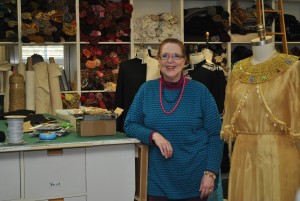
On the other side of the building, Verona Green works works as the costume director for Utah Opera. Instead of wood, nails and canvas her tools are fabric, leather, beads and accessories.
Green started out 34 years ago as a stitcher and last year was named Costume Director.
She deals directly with the stage director for productions. She finds out what the director’s “vision” for a show is and then first looks through the vast inventory to see if something they already have in stock will work. If not, she starts from scratch and tries to help bring to life a director’s dream.
Utah Opera has a vast collection of costumes stored in complete opera sets or as collections of types of costumes such as clerics, soldiers and peasants. Costume rentals in the U.S. and Canada generate a tremendous source of income for the company.
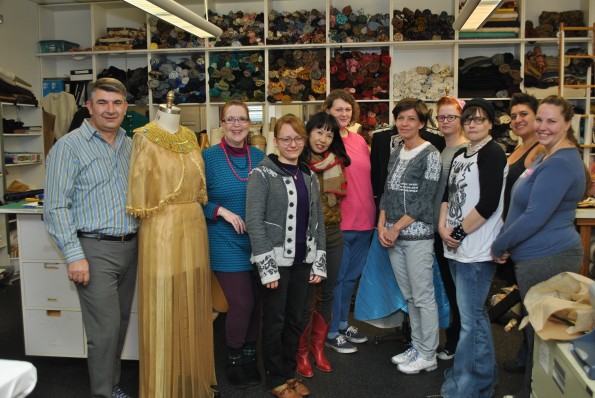
The department has stitchers, drapers, fabric dyers and shippers. “There is a lot of crossover in the shop, and people can step in and do multiple jobs.” It also helps she says, “that everyone in the thinks visually.” They all speak the same language, especially when there is so much going on all at once in the shop between designing, cutting, fitting, organizing and boxing up rentals.
She remembers working on costumes for The Merry Widow, 15 years ago. They spread the build over 7 months because it involved so many costumes. “Every chorus woman had 3 outfits and 3 hats and them men all had tails and that was just the chorus. There was even more for the leads.”
Her first year as costume director Green built 4 shows; Madame Butterfly, The Pearl Fishers, Cosse Fan Tutte and The Rake’s Progress, with fabric that was hand painted in Italy 30 years ago
Green is now creating new costumes for Utah Opera’s Aida. The company had a set on-hand, but the director wanted something new and so they started from scratch. She explained that they will sell the old costumes to another company to make room for the new.
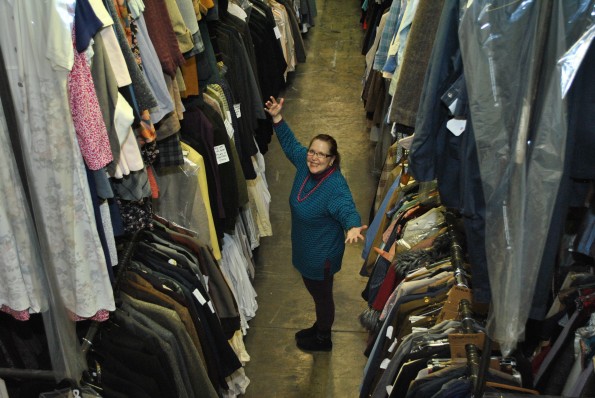
Walking through rows of costumes, Green stops to explain where a fabric came from, or how she found a particular piece of accent, and with a smile says, “It’s so much shopping.”
Story by Connie Lewis






